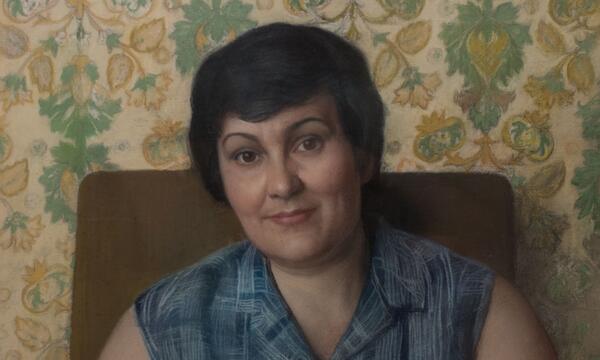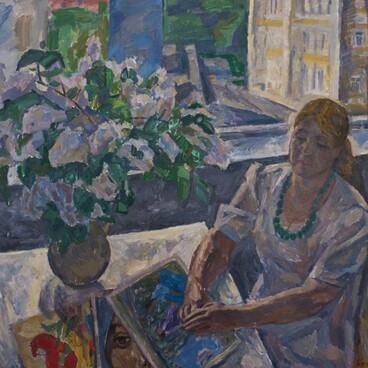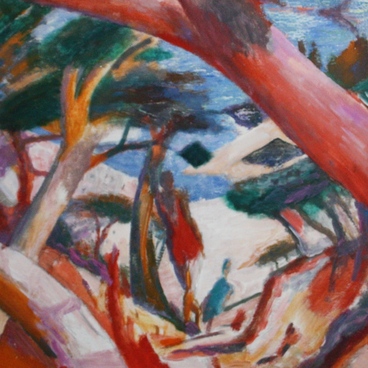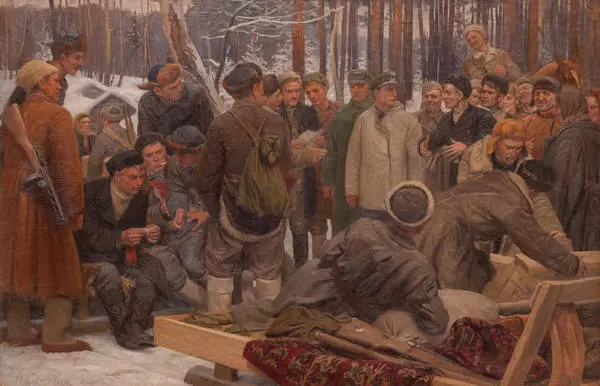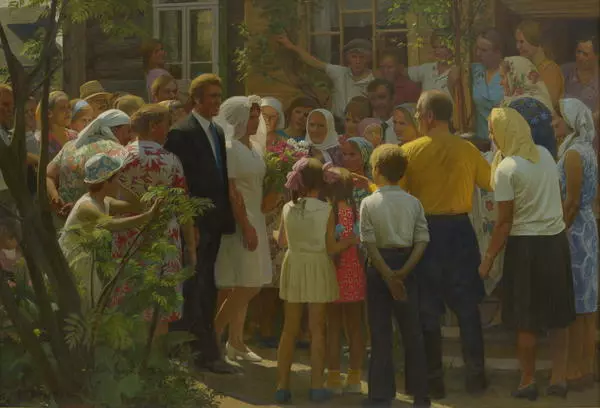The artist Nikolay Solomin created the painting “Portrait of the economist N. S. Ukraintseva” in the pastel technique, which was uncommon for Soviet artists. The painting depicts a middle-aged woman in a light sleeveless dress and with a short haircut.
Pastel is material for fine art, as well as the drawing technique. Works done in pastel on paper are classified as graphics.
Pastel consists of a pigment and a certain amount of binder and can be waxy, oily, and dry. To work with such crayons, a textured, rough surface is required — sandpaper, a board made of cork particles or velvety fabric.
Solomin drew “Portrait of the Economist…” meticulously, elaborating the smallest details. The artist managed to achieve photographic verisimilitude with the help of stumping — rubbing strokes. With this technique, an artist creates elements of chiaroscuro and natural tonal transitions.
Nikolay Solomin was born in 1916 in Moscow. He graduated from the State Art and Pedagogical College in Memory of 1905 in the class of Professor Nikolay Krymov. Then he entered the Surikov Moscow Art Institute without an exam, which was very rare. World War II interrupted his studies. Solomin went through the whole war as a private of the 18th Division of the People’s Militia and was taken prisoner.
In 1948, Solomin completed his studies at the Institute and was accepted into the Union of Artists of the USSR. Two years later, he began participating in exhibitions. In 1954, Solomin, among other artists, was involved in the restoration of the large-scale panorama “The Siege of Sevastopol” by Franz Roubaud, which was severely damaged in 1942 during a fire and evacuation by water.
Nikolay Solomin became famous in the Soviet Union for his paintings on post-war village life — “Decree on Land”, “Returning from War”, “Responsible Job”, “A Broken Promise”. Portraiture has a special place in the artist’s work — during his career, Solomin created a whole gallery of images of his contemporaries. He contributed greatly to the formation of the Soviet realistic school of painting and drawing.
Nikolay Solomin died in 1999 in Moscow. Today, the artist’s works are kept in the Tretyakov Gallery and many regional museums, as well as private collections in France and Japan.
Pastel is material for fine art, as well as the drawing technique. Works done in pastel on paper are classified as graphics.
Pastel consists of a pigment and a certain amount of binder and can be waxy, oily, and dry. To work with such crayons, a textured, rough surface is required — sandpaper, a board made of cork particles or velvety fabric.
Solomin drew “Portrait of the Economist…” meticulously, elaborating the smallest details. The artist managed to achieve photographic verisimilitude with the help of stumping — rubbing strokes. With this technique, an artist creates elements of chiaroscuro and natural tonal transitions.
Nikolay Solomin was born in 1916 in Moscow. He graduated from the State Art and Pedagogical College in Memory of 1905 in the class of Professor Nikolay Krymov. Then he entered the Surikov Moscow Art Institute without an exam, which was very rare. World War II interrupted his studies. Solomin went through the whole war as a private of the 18th Division of the People’s Militia and was taken prisoner.
In 1948, Solomin completed his studies at the Institute and was accepted into the Union of Artists of the USSR. Two years later, he began participating in exhibitions. In 1954, Solomin, among other artists, was involved in the restoration of the large-scale panorama “The Siege of Sevastopol” by Franz Roubaud, which was severely damaged in 1942 during a fire and evacuation by water.
Nikolay Solomin became famous in the Soviet Union for his paintings on post-war village life — “Decree on Land”, “Returning from War”, “Responsible Job”, “A Broken Promise”. Portraiture has a special place in the artist’s work — during his career, Solomin created a whole gallery of images of his contemporaries. He contributed greatly to the formation of the Soviet realistic school of painting and drawing.
Nikolay Solomin died in 1999 in Moscow. Today, the artist’s works are kept in the Tretyakov Gallery and many regional museums, as well as private collections in France and Japan.
